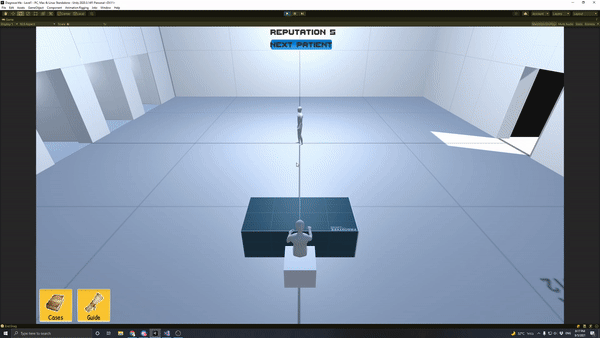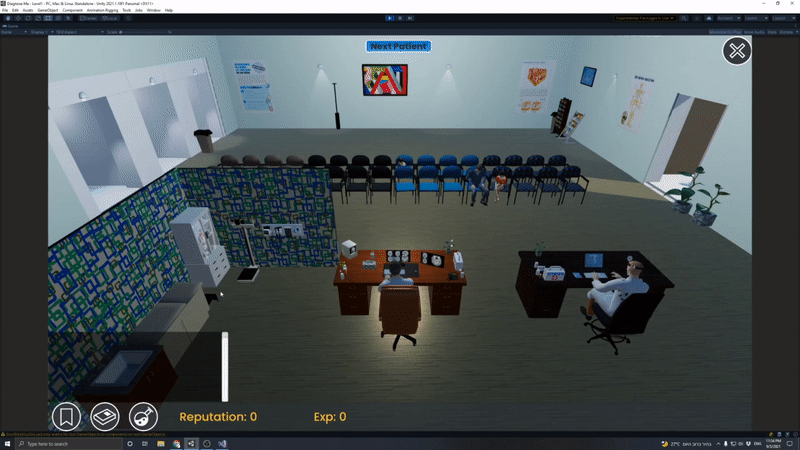The Best Game I Never Released
First, start by watching the official game trailer here
Looks promising, right? well…
At a time when the world was grappling with the uncertainties of Covid-19, my wife and I found ourselves in a unique situation. In the midst of remote work and an abundance of free evenings, a significant change was on the horizon: my wife was pregnant. We saw this as an opportunity to embark on a project that could evolve during her pregnancy and extend into her maternity leave. It was during these discussions that the seed of an idea was planted—Diagnose Me.
With my wife pursuing her Master of Science in Neuroscience, her expertise became a catalyst for this project. She delved into her field of study and swiftly unearthed a fascinating concept that would become the backbone of our game, Diagnose Me.
The Game Concept #
The premise of our game, Diagnose Me, revolved around assuming the role of a doctor attending to a diverse range of patients. The core concept centered on the intricate challenge of identifying and diagnosing various medical conditions, diseases, and even discerning fabricated symptoms, such as those feigned by a teenager seeking to evade school.
To materialize this concept, I established a collaborative workspace using Trello, organizing and outlining the fundamental tasks necessary for implementation. This initial stage laid the foundation for what we envisioned as a captivating and immersive gaming experience.
The Design #
The design of Diagnose Me was meticulously structured into distinct core entities, each vital for the game’s realization:
-
Main Game Loop: This encompassed the foundational code components that structured the gameplay itself— the engine driving the interactive experience between the player and the in-game world of medical mysteries.
-
Content Creation: This aspect was expansive, covering everything from developing game assets to crafting an array of diseases, symptoms, and ailments that would challenge and engage the player’s diagnostic skills.
-
Music and Narration: We recognized the significance of immersive audio elements. The aim here was to incorporate a compelling soundtrack and narrative elements that would heighten the overall gaming experience.
-
Game Promotion: This included strategies to raise awareness about the game, encompassing a range of activities from creating ads to engaging with communities on platforms like Reddit, as well as crafting captivating trailers to showcase the game’s potential.
-
Final Polish: This final stage was intended to refine and perfect every aspect of the game, ensuring a seamless, polished product ready for release.
The systematic breakdown of these components was a critical first step. However, what became apparent as we delved deeper into the development process was the enormity of the challenge we had taken on.
The Process #
The initial idea was refreshingly simple: an NPC (non-playable character) approaching the player, who embodies the role of the doctor, followed by a menu allowing the selection of various symptoms and corresponding actions. This straightforward concept allowed for the swift creation of a technical demonstration. Utilizing an open-source tool for 3D human models, we soon had a functional game loop that provided a glimpse of our vision.

The excitement was palpable as the project began to take shape. Encouraged by the promising start, we dedicated countless hours—weekends and late nights—making significant strides. With the acquisition of additional assets and the incorporation of diverse elements, such as a baby being held and a bustling waiting room filled with varied individuals, the game began to evolve.

As the development progressed, the game underwent further enhancements. A comprehensive “doctor’s guide” was swiftly integrated, and we delved into inventing additional mechanics, including a skill tree, diverse animations, and the integration of a multitude of assets. The depth and complexity of the game expanded rapidly.
What Went Wrong? #
The journey we embarked on with Diagnose Me encountered its fair share of hurdles, and if I’m being honest, the primary culprit was an all-too-familiar foe: scope creep.
In our crazy stride to create an engaging and immersive experience, we found ourselves continuously expanding the game’s features. What began as a simple and focused concept gradually ballooned as we added more elements. I vividly recall a significant diversion from our initial plan—a detour that saw the introduction of a skill tree. What was meant to be a straightforward progression system transformed into a complex network of player choices, reflecting my enthusiasm for granting players a heightened sense of freedom within the game.
This shift resulted in an abundance of tasks, some seemingly endless, contributing to a gradual decline in motivation. Even as positive feedback trickled in from the trailer, the creeping sense of overwhelm began to overshadow our initial excitement. Factor in the life-changing event of welcoming a new addition to our family, and the perfect storm emerged, leading to an unfortunate consequence—an unfinished game.
Will We Ever Finish It? #
As for whether Diagnose Me will ever get finished, I’m honestly not too sure.
Even if we slashed off half of the planned content, that buzz and excitement—the main thing that drives me in all my personal projects—just isn’t there anymore. I’m not sure if that same level of enthusiasm will ever come back for this project.